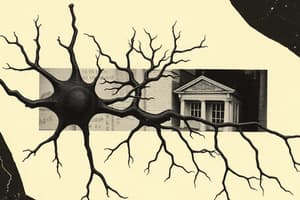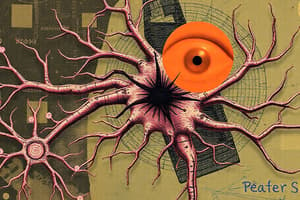Podcast
Questions and Answers
What is one of the main uses of the information obtained from the Human Genome Project?
What is one of the main uses of the information obtained from the Human Genome Project?
Which of the following is a potential ethical concern related to personalized medicines derived from genetic information?
Which of the following is a potential ethical concern related to personalized medicines derived from genetic information?
What is the first step in producing drugs using genetically modified microorganisms?
What is the first step in producing drugs using genetically modified microorganisms?
How are genetically modified plants created to produce specific proteins?
How are genetically modified plants created to produce specific proteins?
Signup and view all the answers
What benefit do herbicide-resistant genetically modified crops provide?
What benefit do herbicide-resistant genetically modified crops provide?
Signup and view all the answers
What is the function of neurotransmitters at a synapse?
What is the function of neurotransmitters at a synapse?
Signup and view all the answers
Which structure is involved in the release of neurotransmitters?
Which structure is involved in the release of neurotransmitters?
Signup and view all the answers
What occurs after neurotransmitters bind to receptors on the postsynaptic membrane?
What occurs after neurotransmitters bind to receptors on the postsynaptic membrane?
Signup and view all the answers
What is the purpose of removing neurotransmitters from the synaptic cleft?
What is the purpose of removing neurotransmitters from the synaptic cleft?
Signup and view all the answers
What is the sequence of events that occurs following an action potential reaching the presynaptic neurone?
What is the sequence of events that occurs following an action potential reaching the presynaptic neurone?
Signup and view all the answers
What is the primary role of the synaptic cleft?
What is the primary role of the synaptic cleft?
Signup and view all the answers
Which of the following neurotransmitters is involved in muscle contraction and heart rate regulation?
Which of the following neurotransmitters is involved in muscle contraction and heart rate regulation?
Signup and view all the answers
What results from synaptic divergence?
What results from synaptic divergence?
Signup and view all the answers
What role does summation play at synapses?
What role does summation play at synapses?
Signup and view all the answers
Which neurotransmitter is primarily affected in Parkinson's disease?
Which neurotransmitter is primarily affected in Parkinson's disease?
Signup and view all the answers
How does L-dopa help individuals with Parkinson's disease?
How does L-dopa help individuals with Parkinson's disease?
Signup and view all the answers
Which drug increases serotonin levels by preventing its reuptake?
Which drug increases serotonin levels by preventing its reuptake?
Signup and view all the answers
What effect does nicotine have when it binds to nicotinic receptors?
What effect does nicotine have when it binds to nicotinic receptors?
Signup and view all the answers
How does lidocaine function as a local anesthetic?
How does lidocaine function as a local anesthetic?
Signup and view all the answers
Which disorder is associated with low serotonin levels?
Which disorder is associated with low serotonin levels?
Signup and view all the answers
What is a characteristic of cobra venom?
What is a characteristic of cobra venom?
Signup and view all the answers
What mechanism allows MDMA to elevate mood?
What mechanism allows MDMA to elevate mood?
Signup and view all the answers
Study Notes
Synapse Structure and Function
- A synapse is the junction connecting a neurone to another neurone or to an effector cell, such as muscle or gland cells.
- The synaptic cleft is the minute gap separating the cells at a synapse.
- The presynaptic neurone features a synaptic knob, containing synaptic vesicles that are rich in neurotransmitters.
- Action potentials trigger the release of neurotransmitters into the synaptic cleft, allowing them to diffuse and bind to receptors on the postsynaptic membrane.
- Binding of neurotransmitters can trigger action potentials in neurones, cause muscle contractions, or induce hormone secretion from glands.
- Synapses ensure unidirectional impulse transmission, as receptors are exclusively located on the postsynaptic membranes.
- Neurotransmitters must be removed from the cleft to prevent continual stimulation, either by reuptake into the presynaptic neurone or by enzymatic breakdown.
Types and Roles of Neurotransmitters
- Various neurotransmitters exist, including acetylcholine (muscle contraction and heart rate control) and dopamine.
- Synaptic divergence allows one neurone to connect to multiple neurones, spreading information.
- Synaptic convergence involves multiple neurones connecting to a single neurone, amplifying signals.
Summation and Nervous Response
- Weak stimuli may result in insufficient neurotransmitter release to reach the action potential threshold.
- Summation aggregates the effects of neurotransmitters from multiple neurones or repeated stimulation from a single neurone.
Neurotransmitter Imbalances and Disorders
- Parkinson's Disease results from a loss of dopamine-producing neurones, leading to reduced dopamine availability and symptoms such as tremors and slow movement.
- Antidepressants addressing depression target serotonin levels, believed to influence mood.
- Selective serotonin reuptake inhibitors (SSRIs) increase serotonin availability by inhibiting its reuptake.
Drug Effects on Synaptic Transmission
- L-dopa serves as a Parkinson's treatment, converting to dopamine in the brain to enhance motor control.
- MDMA elevates serotonin levels by blocking reuptake and stimulating release, resulting in mood enhancement.
- Nicotine mimics acetylcholine, activating postsynaptic receptors and influencing heart rate and dopamine release, but can cause addiction and adverse effects at high doses.
- Lidocaine, a local anesthetic, blocks sodium channels to prevent pain sensation and manage heart arrhythmias.
- Cobra venom binds to acetylcholine receptors at neuromuscular junctions, leading to muscle paralysis and potential respiratory failure.
The Human Genome Project and Drug Development
- The Human Genome Project identified human DNA genes, facilitating the discovery of disease-related proteins.
- Genetic variations can inform drug efficacy, leading to personalized medicine strategies tailored to individual responses.
- Developing drugs for specific genetic profiles can enhance treatment effectiveness but raises ethical concerns regarding cost and accessibility.
GMO Production of Drugs
- Genetically modified organisms (GMOs) can produce therapeutic proteins.
- In microorganisms, the protein-coding gene is amplified, inserted into plasmids, and the modified organisms produce the drug.
- In plants, the gene is transferred via bacteria, with the entire plant expressing the drug-producing gene.
- In animals, genes are injected into fertilized eggs, producing transgenic animals that secrete proteins in their milk.
Benefits and Risks of Genetic Modification
- GMOs enhance agricultural productivity through traits like herbicide resistance.
- The risks associated with GMOs include potential health impacts and ecological concerns, necessitating careful regulation and management.
Studying That Suits You
Use AI to generate personalized quizzes and flashcards to suit your learning preferences.
Description
Explore the fascinating world of synapses, the junctions that connect neurons and their target cells. This quiz delves into the structure and function of the synaptic cleft, presynaptic neurons, and neurotransmitters, providing a comprehensive overview of neuronal communication.



